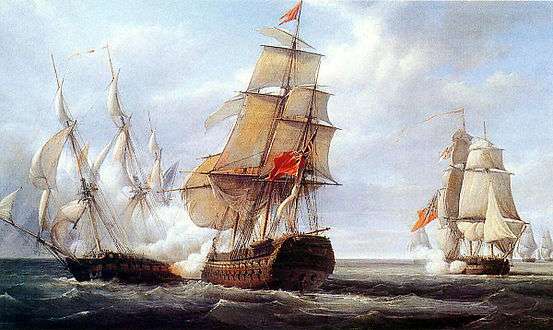HMS Tremendous (1784)
 The Action of 21 April 1806 as depicted by Pierre-Julien Gilbert. In the foreground, HMS Tremendous aborts her attempt at raking Cannonière under the threat of being outmanoeuvered and raked herself by her more agile opponent. In the background, the Indiaman Charlton fires her parting broadside at Cannonière. The two events were in fact separated by several hours. | |
| History | |
|---|---|
| Name: | HMS Tremendous |
| Ordered: | 1 January 1782 |
| Builder: | Barnard, Deptford |
| Laid down: | August 1782 |
| Launched: | 30 October 1784 |
| Renamed: | HMS Grampus, 1845 |
| Fate: | Sold, 1897 |
| General characteristics [1] | |
| Class and type: | Ganges-class ship of the line |
| Tons burthen: | 1,656 64⁄94 (bm)[2] |
| Length: | 169 ft 6 in (51.66 m) (gundeck) |
| Beam: | 47 ft 8 1⁄2 in (14.542 m) |
| Depth of hold: | 20 ft 3 in (6.17 m) |
| Propulsion: | Sails |
| Sail plan: | Full rigged ship |
| Armament: | |
HMS Tremendous was a 74-gun third rate ship of the line of the Royal Navy, launched on 30 October 1784 at Deptford.[1]
Throughout May 1794 Tremendous, whilst under the command of Captain James Pigott, participated in the campaign which culminated in the Battle of the Glorious First of June. Pigott had kept his ship too far to windward of the enemy to make best use of his guns in the battle; Tremendous's captain was one of several denied medals afterwards.[3]
On 11 December 1799, she destroyed the Preneuse at the Battle of Port Louis.
On 21 April 1806, she fought the inconclusive Action of 21 April 1806 against Canonnière[4]
On 13 May she was present at the surrender of Naples during the Neapolitan War. A British squadron, consisting of Tremendous, the frigate Alcmene, the sloop Partridge, and the brig-sloop Grasshopper blockaded the port and destroyed all the gunboats there. Parliament voted a grant of £150,000 to the officers and men of the squadron for the property captured at the time, with the money being paid in May 1819.[Note 1]
Early in September 1811, Primus, carrying tar and hemp, Worksam, in ballast, Experiment, carrying iron, Columbus, carrying linseed, Neptunus, carrying timber, and Hector, carrying sundry goods, came into Yarmouth. They were prizes to Tremendous, Ranger, Calypso, Algerine, Musquito, Earnest. and Portia.[6]
Fate
In 1845 she was reduced to a 50-gun ship, and renamed HMS Grampus. Grampus became a powder hulk in 1856, and was eventually sold out of the service in 1897.[1][7]
Notes, citations, references
- Notes;
Citations
- 1 2 3 Lavery, Ships of the Line vol.1, p180.
- ↑ Winfield (2004) p.47.
- ↑ Naval History of Great Britain, Volume I, by William James.
- ↑ Naval History of Great Britain, Volume IV, by William James.
- ↑ The London Gazette: no. 17476. pp. 827–828. 11 May 1819.
- ↑ Lloyd's List, no. 4596, - accessed 16 May 2014.
- ↑ Ships of the Old Navy, Grampus.
- References
- Lavery, Brian (2003) The Ship of the Line - Volume 1: The development of the battlefleet 1650-1850. Conway Maritime Press. ISBN 0-85177-252-8.
- Michael Phillips. Tremendous (74) (1784). Michael Phillips' Ships of the Old Navy. Retrieved 1 November 2008.
- Winfield, Rif & Lyon, David (2004). The Sail and Steam Navy List: All the Ships of the Royal Navy 1815–1889. London: Chatham Publishing. ISBN 978-1-86176-032-6. OCLC 52620555.